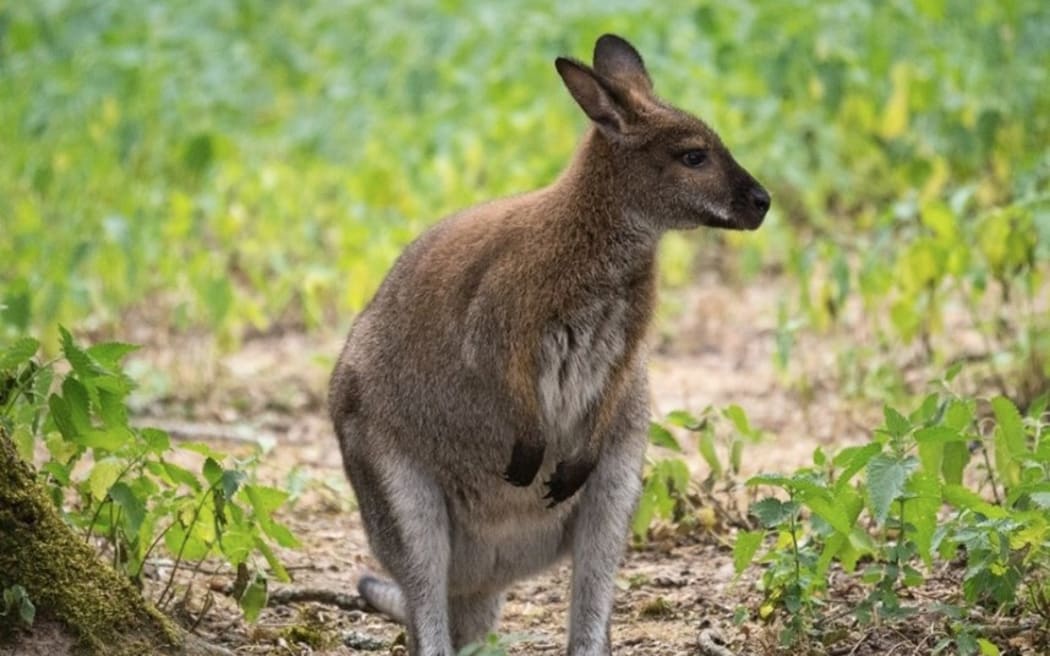Wallabies might look cute and cuddly, but they're a serious pest in New Zealand - and they're advancing towards Aoraki/Mount Cook National Park.

Photo: Supplied
Ripping up farms and edging closer to one of our pristine national parks – wallabies have been here for well over 100 years, but there's concern they've become a pest we've lost control of.
"Wallabies are a cute animal and it's not their fault that they're here in New Zealand," says Brent Glentworth, Environment Canterbury wallaby programme lead.
The marsupials, native to Australia and Papua New Guinea, were introduced to New Zealand in the late 1800s.
One of the country's earliest governors, Sir George Grey, introduced them to Kawau Island, north of Auckland, as a novelty animal for sport.
Six species then made it around New Zealand – and one of the most notable areas is around the South Canterbury town of Waimate.
"Just a few individuals were originally brought in and they ended up escaping or being released...they were doing very well in the high tussock country of South Canterbury," Glentworth says.
But it wasn't until about 1950 – 80 years later their arrival – that wallabies were classed as a pest.
"The damage they were doing to pastures and to fences... they have a high dietary overlap with stock," Glentworth says.
"Anything sheep will eat, wallaby will love, they foul their pasture so where they drop their faeces, stock won't eat around it and that displaces stock."
Authorities tried to get rid of them, with varying results.
"The internal affairs department were the first government department tasked with their control. They shot 10,000 in a few years and never made a dent in that population," Glentworth explains.
"But the real agency that really made a dent in them was...called the South Canterbury Wallaby Board. It was very successful, they did such a good job of getting on top of the wallaby that the problem became almost invisible."
By 1989, the wallaby problem seemed under control.
But once landowners took responsibility for dealing with them, the population crept up again.
A containment area of about 900,000 hectares was set up to try and stop them spreading, but the wallabies are leaking through the boundary.
Some have even been taken out of the area as pets or been released elsewhere.
In an effort to deal with the problem, in 2020 the government gave $27.5 million in funding over four years for Tipu Mātoro, the national wallaby eradication programme.
Dogs, thermal scopes and rifles are commonly used, but they're also testing out new technologies.
Bruce Warburton, science team leader for wildlife ecology and management at Manaaki Whenua Landcare Research, is looking at different ways wallabies can be detected - and the probability that you'll actually find them.
"If you work through an area with a dog, or you fly over an area in a helicopter with a thermal camera and you don't determine anything, how confident can you be that there's nothing there or that you just haven't looked hard enough?"
They're also comparing different toxins and bait, and there's ongoing social research into why people might catch and release wallabies.
"There's no point in spending a lot of money trying to eliminate wallabies outside the containment area if some people then release animals into those areas again," Warburton says.
But can wallabies be eliminated?
"I think we can eliminate local populations outside the containment area," Warburton says.
"To eliminate them or eradicate them from New Zealand, I don't think we have the affordable technology at this stage – we don't have the money to do that.
"Given the advances in any technologies around control and detection, [we can] shrink that containment and that'll be over time, it'll depend strongly on what funding is available."
To find out more about the new tactics being used to get wallabies under control, listen to the full episode.
Check out how to listen to and follow The Detail here.
You can also stay up-to-date by liking us on Facebook or following us on Twitter.

Photo:


